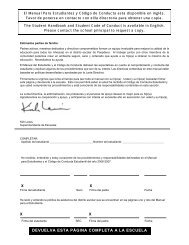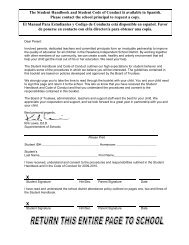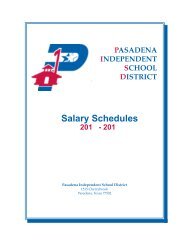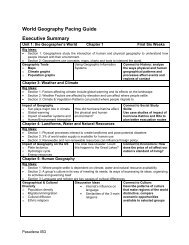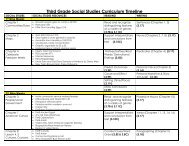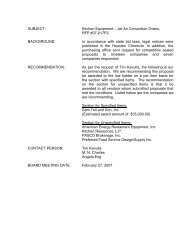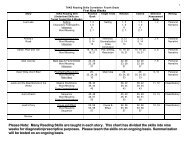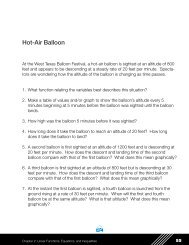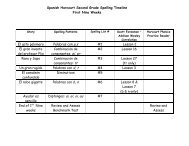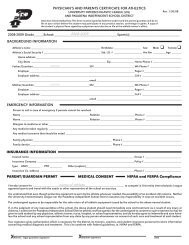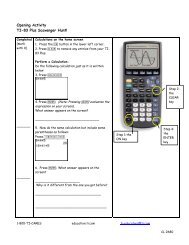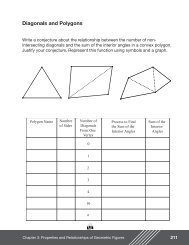Mad as a Hatter or Hat as a Madder
Mad as a Hatter or Hat as a Madder
Mad as a Hatter or Hat as a Madder
Create successful ePaper yourself
Turn your PDF publications into a flip-book with our unique Google optimized e-Paper software.
<strong>Mad</strong> <strong>as</strong> a <strong><strong>Hat</strong>ter</strong> <strong>or</strong> <strong>Hat</strong> <strong>as</strong> a <strong>Mad</strong>der<br />
Problem Set 1<br />
“Then you should say what you mean,” the March Hare went on.<br />
“I do,” Alice h<strong>as</strong>tily replied, “at le<strong>as</strong>t—at le<strong>as</strong>t I mean what I say—<br />
that’s the same thing, you know.”<br />
“Not the same thing a bit!” said the <strong><strong>Hat</strong>ter</strong>. “Why, you might just <strong>as</strong><br />
well say that ‘I see what I eat’ is the same thing <strong>as</strong> ‘I eat what I see’!”<br />
F<strong>or</strong> each of the following conditional statements:<br />
Lewis Carroll, Alice in Wonderland<br />
a) Determine if the <strong>or</strong>iginal statement is true. Explain in writing the<br />
re<strong>as</strong>oning f<strong>or</strong> each of your choices.<br />
b) Write the converse of the statement.<br />
c) Determine if the converse of the statement is true <strong>or</strong> false. Explain in<br />
writing the re<strong>as</strong>oning f<strong>or</strong> each of your choices.<br />
1. If a number is divisible by 4, then it is divisible by 2.<br />
2. If it is raining in L<strong>as</strong> Veg<strong>as</strong>, then it is sunny in Nevada.<br />
3. If it is sunny in Nevada, then it is sunny in L<strong>as</strong> Veg<strong>as</strong>.<br />
4. If a number is greater than -500, then the number is greater than 500.<br />
5. If a person is a teenager, then that person is between 13 and 19 years<br />
old.<br />
6. If a musician plays cl<strong>as</strong>sical guitar, then the musician is a girl.<br />
7. If a girl plays cl<strong>as</strong>sical guitar, then she is a musician.<br />
8. If a person reads a lot, then that person is smart.<br />
9. If a number is even, then it is divisible by 2.<br />
10. If a car is an SUV, then it h<strong>as</strong> four wheels.<br />
H<br />
Chapter 2: Patterns, Conjecture, and Proof 157
11. If a number squared is greater than 1, then the number itself must be<br />
greater than 1.<br />
12. If point B is the midpoint of AC , then the distance from point A to point B<br />
is the same <strong>as</strong> the distance from point B to point C.<br />
13. If a polygon h<strong>as</strong> exactly 8 sides, then it is an octagon.<br />
14. If a parallelogram h<strong>as</strong> a right angle, then it is a square.<br />
15. If a quadrilateral h<strong>as</strong> exactly one pair of parallel sides, then it is a<br />
trapezoid.<br />
Problem Set 2<br />
Write:<br />
1. a non-mathematical statement<br />
and<br />
2. a mathematical statement<br />
that fulfill the following requirements.<br />
1. A true conditional statement with a converse that is also true.<br />
2. A true conditional statement with a converse that is false.<br />
3. A false conditional statement with a converse that is true.<br />
4. A false conditional statement with a converse that is also false.<br />
Problem Set 3<br />
1. Present your statements to fellow cl<strong>as</strong>smates. Be prepared to explain and<br />
justify why you consider your statements either true <strong>or</strong> false.<br />
2. Write a few sentences discussing which types of statements were<br />
e<strong>as</strong>iest to agree on and which types provoked the most disagreement and<br />
discussion.<br />
3. Which statements in Problem Set 1 and Problem Set 2 would you consider<br />
to be definitions? Why?<br />
H<br />
158<br />
Chapter 2: Patterns, Conjecture, and Proof
H<br />
Chapter 2: Patterns, Conjecture, and Proof 159
Materials:<br />
One pencil <strong>or</strong> pen f<strong>or</strong> each<br />
student.<br />
Connections to Geometry<br />
TEKS:<br />
(b.1) Geometric structure. The<br />
student understands the structure<br />
of, and relationships within, an<br />
axiomatic system.<br />
The student:<br />
(A) develops an awareness of<br />
the structure of a mathematical<br />
system, connecting definitions,<br />
postulates, logical re<strong>as</strong>oning, and<br />
the<strong>or</strong>ems;<br />
(b.3) Geometric structure. The<br />
student understands the<br />
imp<strong>or</strong>tance of logical re<strong>as</strong>oning,<br />
justification, and proof in<br />
mathematics.<br />
The student:<br />
(A) determines if the converse of<br />
a conditional statement is true <strong>or</strong><br />
false;<br />
(C) demonstrates what it means<br />
to prove mathematically that<br />
statements are true;<br />
(b.4) Geometric structure. The<br />
student uses a variety of<br />
representations to describe<br />
geometric relationships and solve<br />
problems.<br />
The student:<br />
selects an appropriate<br />
representation (concrete,<br />
pict<strong>or</strong>ial, graphical, verbal, <strong>or</strong><br />
symbolic) in <strong>or</strong>der to solve<br />
problems.<br />
Teacher Notes<br />
Scaffolding Questions:<br />
Problem Set 1<br />
• In writing the converse of a conditional statement: “What<br />
is the hypothesis?” and “What is the conclusion?”<br />
• Guide students <strong>as</strong> necessary toward composing c<strong>or</strong>rect<br />
grammatical sentences rather than simply mechanically<br />
switching the hypothesis with the conclusion.<br />
• Guide students <strong>as</strong> necessary toward providing specific,<br />
concrete counterexamples in <strong>or</strong>der to determine the<br />
converse <strong>or</strong> to establish that statements are false.<br />
F<strong>or</strong> the converse of the statement in Problem Set 1,<br />
question 1: “Can you think of a number that is divisible<br />
by 2, but that is not even?”<br />
In Problem Set 1, question 1: student response: “If it is<br />
divisible by two, then a number is divisible by 4.”<br />
Guiding question: “Can you rewrite your sentence so that<br />
the subject (a number) is part of the hypothesis?”<br />
F<strong>or</strong> Problem Set 1, question 10: students will justify<br />
that the converse of this statement is false with a general<br />
statement like: “Not all cars are SUVs.” An appropriate<br />
question would then be: “ Can you think of a specific car<br />
that h<strong>as</strong> four wheels but is not an SUV?”<br />
Problem Sets 1, 2, and 3<br />
• Student examples often provoke debate among<br />
cl<strong>as</strong>smates about the relative merit and/<strong>or</strong> truth of<br />
counterexamples. They might not always agree that a<br />
statement is a valid counterexample.<br />
• Students are <strong>as</strong>ked to address this issue in Problem<br />
Set 3. Guide students <strong>as</strong> necessary toward making the<br />
distinction between non-mathematical statements,<br />
whose truth can depend on people’s viewpoints<br />
<strong>or</strong> opinions, and mathematical statements, whose truth<br />
depends on logical re<strong>as</strong>oning.<br />
H<br />
160<br />
Chapter 2: Patterns, Conjecture, and Proof
Sample Solution:<br />
Problem Set 1<br />
1. True. Since 4 is divisible by 2, then numbers divisible by<br />
4 must also be divisible by 2.<br />
Converse: If a number is divisible by 2, then it is divisible<br />
by 4.<br />
False: Numbers such <strong>as</strong> 2, 6,and 10 are divisible by 2,<br />
but not by 4.<br />
2. False. If it is raining in L<strong>as</strong> Veg<strong>as</strong>, then it is not sunny<br />
throughout the entire state of Nevada.<br />
Tex<strong>as</strong> Assessment of<br />
Knowledge and Skills:<br />
Objective 10: The student will<br />
demonstrate an understanding of<br />
the mathematical processes and<br />
tools used in problem solving.<br />
Connection to High School<br />
Geometry: Supp<strong>or</strong>ting TEKS<br />
and TAKS Institute:<br />
I. Structure: Bayou City<br />
Geometry<br />
Converse: If it is sunny in Nevada, then it is raining in<br />
L<strong>as</strong> Veg<strong>as</strong>.<br />
False: L<strong>as</strong> Veg<strong>as</strong> would be sunny if it were sunny in<br />
Nevada; theref<strong>or</strong>e it can’t be raining in L<strong>as</strong> Veg<strong>as</strong>.<br />
3. True. Since L<strong>as</strong> Veg<strong>as</strong> is part of the entire sunshinedrenched<br />
state of Nevada.<br />
Converse: If it is sunny is L<strong>as</strong> Veg<strong>as</strong>, then it is sunny<br />
in Nevada.<br />
False. It could be raining in Reno, Nevada while it is<br />
sunny in L<strong>as</strong> Veg<strong>as</strong>.<br />
4. False. 300 is greater than -500 but not greater than 500.<br />
Converse: If a number is greater than 500, then it is<br />
greater than -500.<br />
True. All numbers greater than 500 are positive, and by<br />
definition all positive numbers must be greater than<br />
negative numbers like -500.<br />
5. True. This is the definition of a teenager.<br />
Converse: If a person is between 13 and 19 years old,<br />
then that person is a teenager.<br />
True: This is the definition of a teenager.<br />
6. False. F<strong>or</strong> example, Segovia w<strong>as</strong> a famous male<br />
cl<strong>as</strong>sical guitarist.<br />
Converse: If a musician is a girl, then the musician<br />
plays cl<strong>as</strong>sical guitar.<br />
H<br />
Chapter 2: Patterns, Conjecture, and Proof 161
False: The Dixie Chicks do not play cl<strong>as</strong>sical guitar, but they are girl musicians. (This<br />
is, of course, open to debate. Like many non-mathematical statements, we can’t<br />
always be perfectly sure if they are true <strong>or</strong> false.)<br />
7. True. Cl<strong>as</strong>sical guitar players are all musicians.<br />
Converse: If a girl is a musician, then she plays cl<strong>as</strong>sical guitar.<br />
False. F<strong>or</strong> example, Gl<strong>or</strong>ia Estafan, who is a percussionist.<br />
8. False. Students can argue that there are many ways to have intelligence which have<br />
nothing to do with reading.<br />
Converse: If a person is smart, then they read a lot.<br />
False: F<strong>or</strong> the same re<strong>as</strong>on <strong>as</strong> above. (This is another example of a non-mathematical<br />
statement whose truth is open to debate and interpretation.)<br />
9. True. There are no even numbers that are not divisible by 2.<br />
Converse: If a number is divisible by 2, then it is even.<br />
True. There are no numbers that are even that are not divisible by 2. Or, True by<br />
definition of an even number.<br />
10. True. Since all cars have 4 wheels and an SUV is a type of car.<br />
Converse: If a car h<strong>as</strong> 4 wheels, then it is an SUV.<br />
False. A Volkswagen Beetle is not an SUV and it is a car with 4 wheels.<br />
11. False. -2.<br />
Converse. If a number is greater than 1, then the number squared is greater than 1.<br />
True. Squaring a number greater than 1 makes the number even larger.<br />
12. True. If B is the midpoint of , then by definition, AB = BC.<br />
AC<br />
Converse: If the distance from point A to point B is the same <strong>as</strong> the distance from point<br />
B to point C, then B is the midpoint of .<br />
AC<br />
False. and can be the legs of an isosceles triangle.<br />
AB BC<br />
13. True. This is the definition of an octagon.<br />
Converse: If a polygon is an octagon, then it h<strong>as</strong> eight sides.<br />
True. By definition, an eight-sided polygon is an octagon.<br />
14. False. It could be a rectangle.<br />
Converse: If a parallelogram is a square, then it h<strong>as</strong> a right angle.<br />
H<br />
162<br />
Chapter 2: Patterns, Conjecture, and Proof
True: All squares have right angles by definition.<br />
15. True. This is the definition of a trapezoid.<br />
Converse: If a quadrilateral is a trapezoid, then it h<strong>as</strong> exactly one pair of parallel sides.<br />
True. Definition of a trapezoid.<br />
Problem Set 2<br />
Answers will vary. Check Student W<strong>or</strong>k.<br />
1. Question 5, Problem Set 1 is a true conditional with a true converse.<br />
2. Question 1, Problem Set 1 is a true conditional with a false converse.<br />
3. Question 14, Problem Set 1 is a false conditional with a true converse.<br />
4. Question 2, Problem Set 2 is a false conditional with a false converse.<br />
Problem Set 3<br />
1. and 2. Answers will vary. Students should be able to articulate that, in general,<br />
it’s e<strong>as</strong>ier to decide the truth/falseness of mathematical statements. The terms in<br />
mathematical statements are precisely defined, and their truth depends on logic. In<br />
contr<strong>as</strong>t, the truth/falseness of non-mathematical statements often depends on<br />
people’s opinions and personal understanding of what w<strong>or</strong>ds mean.<br />
3. The statements that make good definitions are the conditional statements that have<br />
true converses.<br />
H<br />
Chapter 2: Patterns, Conjecture, and Proof 163
Extension Questions:<br />
• Refer to questions 3, 7, and 10 in Problem Set 1. F<strong>or</strong> each of these questions,<br />
represent the conditional statement in an Euler Diagram.<br />
Note: Euler (pronounced “oiler”) diagrams are often called Venn Diagrams.<br />
Problem 3<br />
Sunny in Nevada<br />
L<strong>as</strong> Veg<strong>as</strong><br />
Problem 7<br />
girl musicians<br />
girl<br />
cl<strong>as</strong>sical<br />
guitarists<br />
H<br />
164<br />
Chapter 2: Patterns, Conjecture, and Proof
Problem 10<br />
Cars with four<br />
wheels<br />
SUV's<br />
• Write definitions of the following terms <strong>as</strong> true conditional statements with true<br />
converses. Then, rewrite the definitions <strong>as</strong> biconditional statements.<br />
a) complementary angles<br />
b) isosceles triangle<br />
c) polygon<br />
a) If two angles are complementary, then the sum of their me<strong>as</strong>ures is 90°. Two<br />
angles are complementary if and only if the sum of their me<strong>as</strong>ures is 90°.<br />
b) If a triangle is isosceles, then it h<strong>as</strong> at le<strong>as</strong>t 2 sides that are congruent. A triangle<br />
is isosceles if and only if it h<strong>as</strong> at le<strong>as</strong>t two sides that are congruent.<br />
c) If a shape is a polygon, then it is a plane figure f<strong>or</strong>med from 3 <strong>or</strong> m<strong>or</strong>e<br />
line segments, such that each segment intersects exactly 2 other segments,<br />
one at each endpoint, and no 2 segments with a common endpoint are<br />
collinear.<br />
A shape is a polygon if and only if it is a plane figure f<strong>or</strong>med from 3 <strong>or</strong> m<strong>or</strong>e line<br />
segments, such that each segment intersects exactly 2 other segments, one at<br />
each endpoint, and no two segments with a common endpoint are collinear.<br />
• Create and name your own object. It does not have to be mathematical, but it should<br />
be something you can draw. Then, write the definition of your object <strong>as</strong> a biconditional<br />
statement.<br />
Answers will vary. Check student w<strong>or</strong>k.<br />
H<br />
Chapter 2: Patterns, Conjecture, and Proof 165
H<br />
166<br />
Chapter 2: Patterns, Conjecture, and Proof



